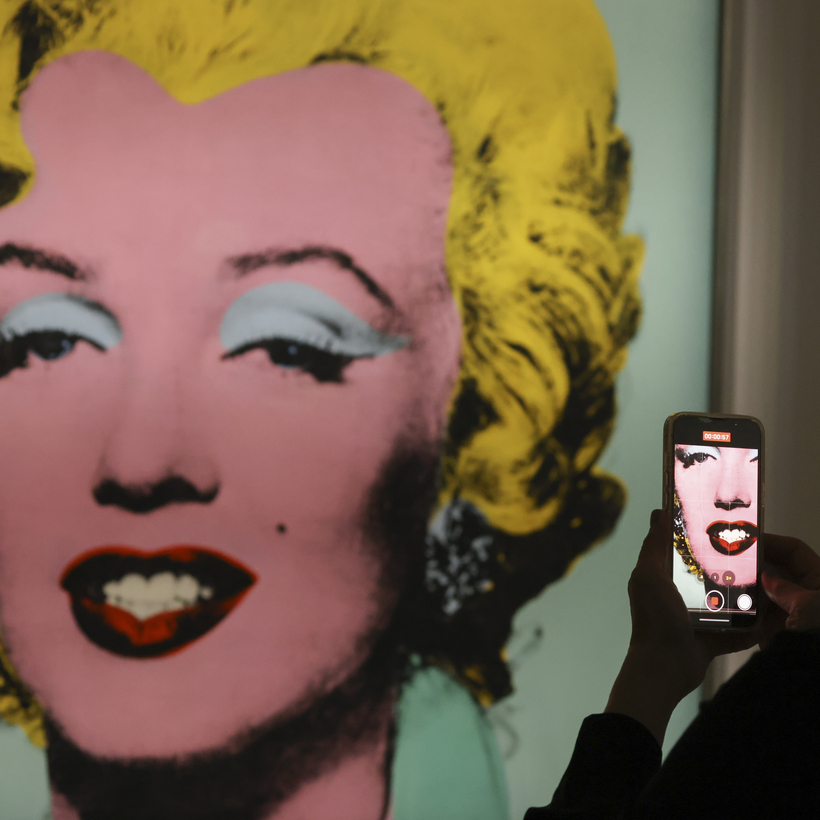In Andy Warhol’s prolific practice there were two subjects he returned to most frequently: himself and Marilyn Monroe. In 1964, he decided to make the most beautiful Marilyns to date. The silk-screenings, the hand-painting, the brushwork, and the care he brought to these were imaginative and exhausting. He said afterward that he might never apply himself so vigorously again.
That September, four of the five just-finished versions of Marilyn were resting in a stack against the wall at the Factory, Warhol’s studio on East 47th Street. The door opened and a man and a woman came in, acquaintances of Warhol’s Factory photographer Billy Name. The woman, wearing black motorcycle leathers and carrying a black handbag, held an antic Great Dane on a leash. She surveyed the studio, her eyes settling on the Marilyns. She asked Warhol, “May I shoot them?”
“Sure,” he replied.
She opened her bag, pulled out a small pistol, and shot the pictures in the forehead.
Warhol’s Shot Sage Blue Marilyn, one of the five 1964 paintings of the actress, is coming to auction at Christie’s in May. Estimated to sell at or above $200 million, it is set to become the world’s most valuable work of 20th-century art.
What is it about this painting, the artist, the subject, that places it in this “highest auction” league: Da Vinci’s Salvator Mundi, $475.4 million; Picasso’s Les Femmes d’Alger (Version O), $195.8 million; and Amedeo Modigliani’s Nu couché (sur le côté gauche), $186.1 million?
On the morning of August 6, 1962—Warhol’s 34th birthday—the world awoke to the news of Monroe’s death. Warhol immediately set to work painting her, choosing for his image a publicity still from her film Niagara. Just three months later, at the Stable Gallery, for his first significant pop art exhibition, this same image of Monroe, in various silk-screened palettes and sizes, comprised a significant share of the hang.

The show was a triumph—it sold out—but the exhibition was more than a commercial success. Warhol’s work was immediately celebrated and embraced by the good and the great of America’s art society. The foremost figure in the artistic community, Jasper Johns; the leading gallerist of the time, Leo Castelli; and architect Philip Johnson all attended the opening. Susan Sontag, Norman Mailer, and other literary luminaries were there as well. Johnson bought Gold Marilyn Monroe and donated it to the Museum of Modern Art.
In his review of the show for Art International magazine, critic Michael Fried wrote, “At his strongest—and I take this to be in the Marilyn Monroe paintings—Warhol has a painterly competence, a sure instinct for vulgarity (as in his choice of colors) and a feeling for what is truly human and pathetic in one of the exemplary myths of our time that I for one find moving.”
To some, these 1964 canvases have become the “holy grail of Warhol.” But how do you put a price on the holy grail?
The common wisdom is that valuing contemporary-art masterpieces requires a mysterious method known only to the secret society of art insiders or an algorithmic code to be cracked by the nerds of big data. At the end of the day, it is neither data nor academic context alone.
She opened her bag, pulled out a small pistol, and shot the pictures in the forehead.
To begin, the value of a work of art, like most things, is simply a question of what someone will pay for it, a fact most easily tracked in public-auction results. Warhol’s current auction record of $104.5 million was set nine years ago when Sotheby’s sold Silver Car Crash (Double Disaster). With a pre-sale estimate of $200 million, Shot Sage Blue Marilyn would double that value. Almost a decade of steady art-market growth would certainly bring up the value, but more importantly, it is well known that one of the other “Shot Marilyns” was purchased privately and with little trace for $200 million around 2018.
Beyond the numbers, there is the provenance: Who has owned the work? And through which collections has the painting passed, acquiring along the way the gloss of the individual collectors’ own aesthetic and mystique? For the “Shot Marilyns,” the combined provenance is stellar. These works held pride of place in the homes of Robert Rauschenberg, the Niarchos family, the Newhouse family, Peter Brandt (who presciently bought his Shot Blue Marilyn in 1967), and more.
Shot Sage Blue Marilyn was first acquired by Leon Kraushar, a well-known New York–based insurance broker and eccentric collector of pop art; then Castelli; and eventually S. I. Newhouse Jr., who sold it to Thomas Ammann, the eminent Zurich collector and gallerist. Joining the Ammann collection was in a way a homecoming. Ammann had known Warhol since he was 18, when the young Ammann worked for Bruno Bischofberger, the famed Zurich art dealer.

By 1968, Bischofberger had become Warhol’s key adviser, eventually introducing him to Jean-Michel Basquiat and sponsoring their working together (the subject of the current Off West End play The Collaboration). Ammann and Warhol became close. A lifelong supporter, he co-published the first two volumes of Warhol’s catalogue raisonné. He died in 1993. The picture is being sold with all proceeds going to the Thomas and Doris Ammann Foundation Zurich, assisting research into cancers and immunological disorders among young people.
Market data, backstory, execution, and provenance all combine to support Shot Sage Blue Marilyn’s rise to the top of the contemporary-art-market ziggurat. But none of the above would matter a whit if the painting did not also grab one by the heartstrings when, in the parlance of collectors, it is seen “in the flesh.” The experience of Shot Sage Blue Marilyn has compelled the greatest of collectors and artists to covet it, to want to live with it.
The power this picture has held since 1964 is extraordinary. It is a phenomenon due to a pairing of artist and subject in equal parts. According to Alex Rotter, Christie’s chairman of 20th- and 21st-century art, “the key to understanding Warhol is to understand his genius of anticipating what is going to be relevant, what is going to be beautiful, what is going to be shocking, in 1964, in 1984, and in 2022.”
We continue to be drawn to Monroe’s story, even today, even as we recognize her tragedy as another example of exploitation and abuse. Joyce Carol Oates’s novel Blonde, a fictional account of Monroe’s life, is coming to the screen this year. In April, Oates published a short-story collection, Night, Neon and Other Stories of Suspense, including “Miss Golden Dreams 1949.” In it, an animatronic doll, built from Monroe’s DNA, is being sold in a Sotheby’s auction—proving once again that great writers and artists anticipate.
So, what drives the value of this great work? Among all of the variants and analyses of pricing, the accelerant that ignites the allure of Shot Sage Blue Marilyn may be that very thing that Warhol sought to create on the canvas: the irresistible pull of beauty and tragedy, evoking that most coveted of all responses, desire.
Steven Murphy, a London–based art consultant and writer, is the former C.E.O. of Christie’s

